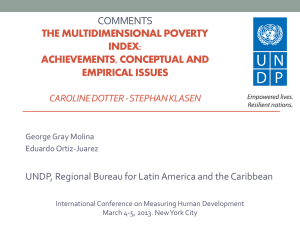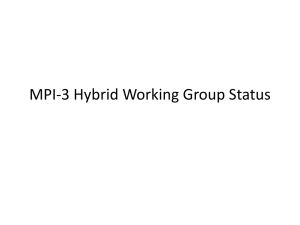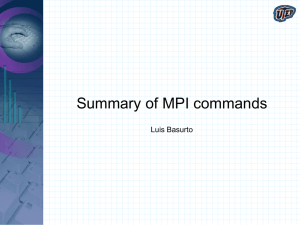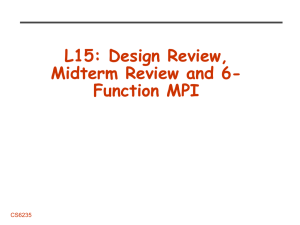Multi-Dimensional Progress
advertisement
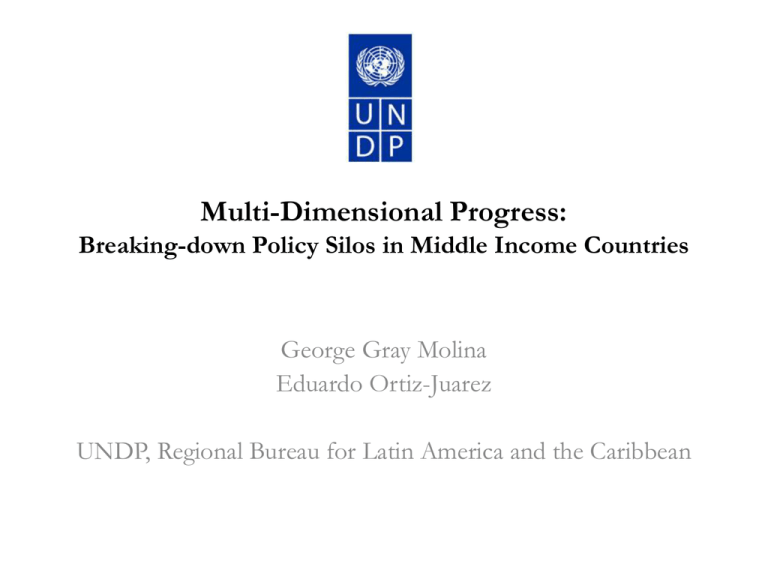
Multi-Dimensional Progress: Breaking-down Policy Silos in Middle Income Countries George Gray Molina Eduardo Ortiz-Juarez UNDP, Regional Bureau for Latin America and the Caribbean Context (1) A new development agenda A global debate to adopt a new multi-dimensional framework for poverty reduction as part of a post-2015 development strategy. Arguments: • Multi-dimensional indicators are valuable inputs for better policy coordination, targeting, and monitoring. • Social policy is more effective and efficient if it customizes its programs to address the different ways of being poor across different populations. Context (2) Area of opportunity for the Caribbean While there is significant progress in Colombia, Mexico, Chile and the Caribbean OECS countries, there is an opportunity to address multidimensional poverty reduction in the rest of the region as we approach 2015. LAC will embark on a new round of readjustment to global goals and means of implementation. The best measurements are those that can be disaggregated and applied in ways that fit the needs of our countries. High-threshold, nation-specific indices of multidimensional progress 1. In RBLAC we are working on designing nation-specific multidimensional indices calibrated at development thresholds appropriate to the needs of the working poor, vulnerable groups and emerging middle classes. 2. We have now an informative, methodologically robust MPI as the basis for comparability. 3. The MPI has been successful as the multi-dimensional counterpart of the $1.25 poverty line. 4. However, very rudimentary goods and services (as well as the $1.25 standard) are becoming less relevant for a growing number of countries whose welfare thresholds are significantly higher. Relativity of the dimensional cut-offs What are we looking for? In partnership with OPHI, we are seeking for a context-specific index as guidance for policy in middle-income countries. What does it mean to be poor? “one might consider whether one should construct a relative MPI cut-off that rises with average well-being in a country” (Dotter & Klasen 2013; pp. 8). “Rising average living standards in many developing countries have triggered a reassessment of what it means to be considered poor” (Ravallion 2012; pp. 40). Counterpart of the $2.5/$4 a day poverty lines… Should the multi-dimensional measurement be restricted to the MPI in regions with different levels of development? $4 a day $5 a day Central and Eastern Europe and the CIS 12 millions 0.7% $1.25 a day Sub-Saharan Africa 458 millions 27.6% And, accordingly, with different monetary poverty lines? Latin America and Caribbean 51 millions (3.1%) East Asia and the Pacific 255 millions 15.4% South Asia 844 millions 50.9% Arab States 39 millions 2.3% $2 a day Which dimensions are relevant in each region? Which are relevant across countries in the same region? An example of higher thresholds relative to LAC Dimension Indicator Material well-being Education Dwelling Brazil Dimensional cut-offs Asset index Having a car Child in school All children between 7 and 15 attending school Education of the head At least five years of education Running water Having tap water in the dwelling Sanitation Having flush toilet in the dwelling Quality of living space House with non-precarious materials Nicaragua Uruguay 70.0 60.0 Meaningful for policy purposes (LAC-specific) 50.0 40.0 What about other countries? 30.0 20.0 10.0 0.0 Incidence Breadth MPI Original MPI (cut-off = 1/3) Incidence Breadth MPI Region-specific MPI (cut-off = 1/3) Source: HDR 2011, and own calculations. All three indicators are expressed in %. Also, counterpart of the vulnerability and middle class thresholds (i.e. the non-income poor) Also, counterpart of the vulnerability and middle class thresholds Nonpoor Poor What is the multi-dimensional threshold/profile of those stratified under a monetary approach? Distribution of groups in Mexico, 2012 Mill. Groups Percent People Ultra-poverty (< $1.25) 4.4 3.7 27.6 mill. Extreme ($1.25 - 2.5) 9.1 7.8 (23.5%) Moderate ($2.5 - 4) 14.1 12.0 Vulnerable ($4 - 10) 48.3 41.2 89.7 mill. Middle-class ($10 - $50) 38.9 33.1 (76.5%) Upper-class (> $50) 2.6 2.2 Total 117.3 100 Nation-specific index A.1 Selection of indicators/dimensions. Two potential approaches: a. “People tend to value…” through (expensive, non-systematic) cross-country opinion polls and participatory exercises. b. “People have/have no…” appropriate to their needs and the local context (i.e. needs might be very different in Grenada and Uruguay, even if the same set of potential indicators is available for the same group; for instance the vulnerable). We follow the latter approach using factorial/principal component analysis to identify those needs of the poor, the vulnerable, and the middle class in Mexico. Nation-specific index A.2 Selection of indicators/dimensions among the poor. The needs of the poor in Mexico, 2012 Ultra-poverty Extreme poor Moderate poor (< $1.25) ($1.25 - 2.5) ($2.50 - 4) Assets Radio Sewing machine Fan Bicycle Washing machine DVD or BluRay Microwave / Oven Motorcycle Dwelling and related services Some source of water Electricity Some source of water Water tank Room for cooking Drainage Flooring Some source of water Water tank Wall materials Private toilet Labor income Non-contributory pensions Self-employment Access to food Market and state forces Non-contributory pensions Health services Source: Gray Molina & Ortiz-Juarez (in progress), based on ENIGH 2012 Nation-specific index A.3 Selection of indicators/dimensions among the non-poor. The needs of the non-poor in Mexico, 2012 Vulnerable ($4.0 - 10) Middle-class ($10.0 - 50) Upper-class (> $50) Assets Bicycle Tape recorder Washing machine TV Pickup truck Showerhead Car Stereo Printer Heating / A.C. Roaster Homeownership Car Stereo PlayStation, Xbox Computer DVD or BluRay Dwelling and related services Room for cooking Overcrowding Flooring Roofing material Running water Drainage Gas tank Market and state forces Health services Social security Retirement fund Social security Disability insurance Labor income Rental income Source: Gray Molina & Ortiz-Juarez (in progress), based on ENIGH 2012 Nation-specific index B. Measurement and aggregation In progress for Chile, Dominican Republic and Mexico. The results depend on particular place at particular time; therefore, they are not comparable. Instead, they would change in parallel with nation-specific economic growth, redistributive policies, technological change, and consumption patterns in order to inform policy makers. In this example, we use a dual cut-off in the spirit of Alkire-Foster: 1. 2. Deprived or not, in each indicator Deprived in k or more indicators to be identified as (multi-dimensionally) poor, vulnerable, and middle class. (We are working on weighting and a third cut-off intended to separate mutually exclusive groups; i.e. the multi-dimensionally vulnerable would not include the multi-dimensionally poor as their needs differ). The case of the multi-dimensionally ‘ultra-poor’ The principal components analysis yielded 7 indicators for the ultra-poor. Ultra-poverty (< $1.25) Assets Radio Sewing machine Fan Dwelling and related services Some source of water Electricity Market and state forces Using the threshold of 1/3 proposed by Alkire and Santos (2010), one individual would be identified as multi-dimensionally ultra-poor if he/she is deprived in more than 2 out of 7 indicators. The results are shown below: Groups Ultra-poor (< $1.25) Ultra-poor (PCA) MPI mid-2000s Non-contributory pensions Health services Source: Gray Molina & Ortiz-Juarez (in progress), based on ENIGH 2012 Mill. Percent People 4,369,338 3.7% 3,241,537 2.8% 4,540,005 4.1% Overall • We are working on provide a toolkit to diagnose and monitor good practice in attaining multi-dimensional progress at local and national government levels in the region. • Informative for regional governments, and useful for resources targeting.

